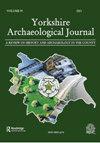Clerk to Haworth Currer of Kildwick Hall: The Career of Henry Newby (1699/1700-1769)
IF 0.2
0 ARCHAEOLOGY
引用次数: 0
Abstract
Abstract Henry Newby was ‘clerk’ (to use his own term), or steward, to Haworth Currer Esq. of Kildwick Hall, near Keighley in West Yorkshire. He assisted his master in the management of the family estate, and continued to manage this property largely single-handedly after the death in 1744 at a comparatively young age of Currer, whose heir was a minor and whose widow was living away from Kildwick in the family’s town house at York. Newby’s accounts survive in the Bradfer-Lawrence collection of the Yorkshire Archaeological & Historical Society and they, with material in two other archives, provide evidence for the painstaking work he performed in the service of the Currers, who were affected by further premature deaths, leading eventually to the extinction in the direct line of the family. The career of Newby illustrates the importance of the steward in the rural economy of eighteenth-century Yorkshire and in the lives of its landed-gentry families.Kildwick Hall的Haworth Currer办事员:亨利·纽比的职业生涯(1699/1700-1769)
摘要Henry Newby是西约克郡Keighley附近Kildwick Hall的Haworth Currer先生的“办事员”(用他自己的话说)或管家。他协助他的主人管理家族财产,并在1744年柯勒去世后继续独自管理这处财产,当时柯勒的年龄相对较小,他的继承人是一名未成年人,他的遗孀住在远离基尔德威克的约克镇上。纽比的叙述保存在约克郡考古与历史学会的布拉德弗·劳伦斯收藏中,这些叙述与另外两份档案中的材料一起,为他为柯勒斯家族服务所做的艰苦工作提供了证据,柯勒斯家族受到了更多过早死亡的影响,最终导致了该家族的直系亲属灭绝。纽比的职业生涯说明了管家在18世纪约克郡农村经济和土地贵族家庭生活中的重要性。
本文章由计算机程序翻译,如有差异,请以英文原文为准。
求助全文
约1分钟内获得全文
求助全文

 求助内容:
求助内容: 应助结果提醒方式:
应助结果提醒方式:


